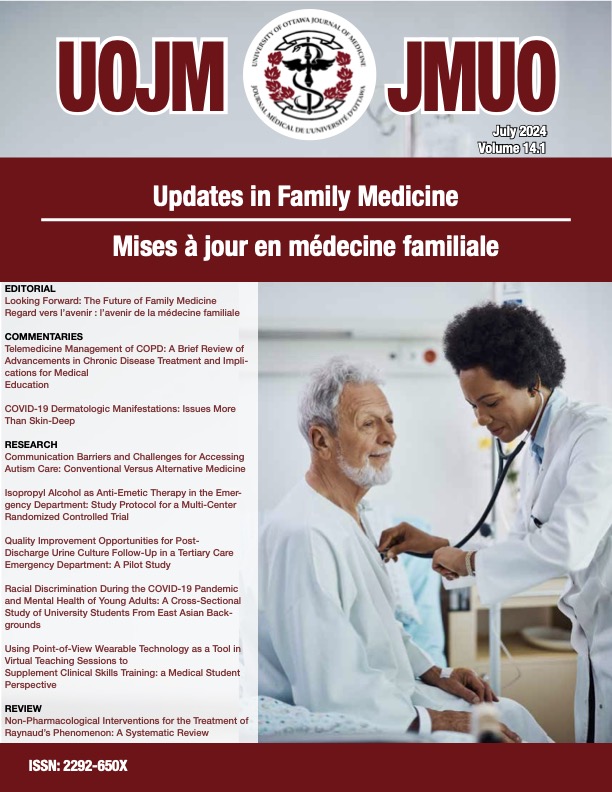Isopropyl alcohol as anti-emetic therapy in the emergency department: study protocol for a multi-center randomized controlled trial
DOI:
https://doi.org/10.18192/uojm.v13i1.6100Keywords:
emergency department; isopropyl alcohol; inhalation; nausea; vomitingAbstract
Background: Nausea and vomiting is a common and distressing presenting complaint in Emergency Departments (EDs). There is no definite evidence to support the superiority of any anti-emetic therapy over another, or over placebo. Identification of an effective anti-emetic therapy in the ED setting with minimal side effects would be of great benefit. Isopropyl alcohol inhalation has been reported to be an effective treatment for post-operative nausea and vomiting, with no reported adverse events. The objective of this study is to determine if nasally inhaled isopropyl alcohol swabs are effective in alleviating nausea and/or vomiting in patients presenting to the ED with a chief complaint of nausea and/or vomiting.
Methods: We will conduct a randomized, controlled, multicenter trial with three subject arms: 1) nasally inhaled isopropyl alcohol swabs every 10 minutes for a total of one hour, 2) nasally inhaled isopropyl alcohol swabs every 20 minutes for a total of one hour, or 3) no intervention. 135 participants ≥18 years old and presenting to the ED with a chief complaint of nausea and/or vomiting with a level of 3 or greater on a verbal numeric rating scale (NRS) will be recruited for a duration of two hours. The primary outcome measure is the mean reduction in nausea scores comparing the pre-intervention score to the lowest post-intervention nausea score. The secondary outcome measures will be participant satisfaction scores using a verbal NRS, receipt of any rescue anti-emetic medications, ED length of stay, and participant disposition (admission or discharge home).
Discussion: This study will determine the efficacy of inhaled isopropyl alcohol swabs by determining the optimal dosing frequency achieving adequate anti-emetic action. This has the potential to guide future triage protocols to incorporate this therapy to provide earlier symptomatic relief to patients, and also has the potential to prevent morbidity suffered by patients in the emergency department and improving patient satisfaction and efficiently use in-patient resources. We strongly suspect that once this study is performed, it will be useful for ED physicians in treating nausea and vomiting in the ED.
Downloads
Published
Issue
Section
License
Copyright (c) 2024 Alexandra Hamelin , Ali Shahbaz Syed, Venkatesh Thiruganasambandamoorthy

This work is licensed under a Creative Commons Attribution-NonCommercial-NoDerivatives 4.0 International License.
- Authors publishing in the UOJM retain copyright of their articles, including all the drafts and the final published version in the journal.
- While UOJM does not retain any rights to the articles submitted, by agreeing to publish in UOJM, authors are granting the journal right of first publication and distribution rights of their articles.
- Authors are free to submit their works to other publications, including journals, institutional repositories or books, with an acknowledgment of its initial publication in UOJM.
- Copies of UOJM are distributed both in print and online, and all materials will be publicly available online. The journal holds no legal responsibility as to how these materials will be used by the public.
- Please ensure that all authors, co-authors and investigators have read and agree to these terms.
- Works are licensed under a Creative Commons Attribution-NonCommercial-NoDerivatives 4.0 International License.


